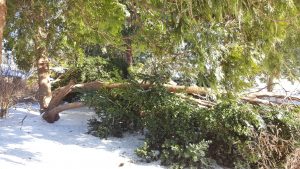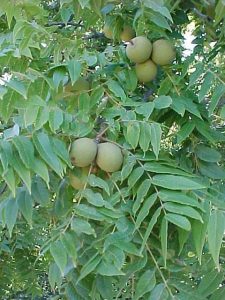The storm on Tuesday left broken branches and damage due to freezing temperatures. 

New Citizen Science Project – A Tree's Life!
North Carolina State is starting a "citizen science" project to help understand how climate and urbanization affect tree growth and carbon sequestration. You can be a part of this project and follow tree growth over the next few years. A study of red maple trees in urban sites will help in the study of tree response to global change.

A Tree's Life goal is to understand tree growth, and thus services, across latitudinal, attitudinal, and urbanization gradients. Volunteers just need a red maple (Acer rubrum) in their yard and we will send them a dendrometer to measure annual DBH growth. This is an easy project for homeowners, Master Gardeners, or even schools or gardens.
For more info and to sign up visit the project web page:
http://ecoipm.org/a-trees-life/
NFG 3/16/2017
72nd Meeting of the NJDelMarVaPa Plant Pathologists
 pathology group, held at the University of Delaware. We had a good meeting and some lively discussions! Student work was presented, as well as research and disease updates from regional colleagues. This casual meeting is one of the best regional opportunities for networking and updates.
pathology group, held at the University of Delaware. We had a good meeting and some lively discussions! Student work was presented, as well as research and disease updates from regional colleagues. This casual meeting is one of the best regional opportunities for networking and updates.NFG 3/12/2017
National Invasive Species Week Feb 27 through Mar 3, 2017
Invasive species may be insects, plants, fungi, animals, or other invasive types of organisms. Invasive species establish at the expense of our native flora and fauna. Be on the lookout for unusual types of things. Early detection and partnerships for management are key to raising awareness and finding solutions!

Delaware Invasive Species Council helps to educate and coordinate efforts in Delaware to eradicate or manage invasive organisms : http://delawareinvasives.net/
Check out the information at the following websites: http://www.nisaw.org/
http://blogs.usda.gov/2016/02/22/national-invasive-species-awareness-week-snakes-starlings-and-swine-oh-my/
NFG 2/27/2017
Apply Horticultural Oil to Control Scale Insects!
We have a couple of good temperature days in which to apply horticultural oil to control scale insect pests... today and tomorrow.
FROM: Stanton Gill, Extension Specialist in IPM and Entomology, University of Maryland, February 6, 2017:
If you have time today or Tuesday, there is a brief window during which to apply dormant horticultural oil. We have a couple of warm days (above 55 F) and when the nighttime temperatures do not sink below freezing in which horticultural oil can be effective.
Over the last couple years, armored and soft scale insects in landscapes have been an increasing problem. The dormant rate horticultural oil appears to work fairly well in controlling overwintering arthropod pests such as scale, mites and eggs of overwintering aphids. One of the least expensive materials for controlling scale insects is horticultural oil. It also kills mite eggs that overwinter on plants and aphid eggs tucked in cracks and crevices of woody plants. Although pesticide prices have skyrocketed over the last 20 years, horticultural oil is still relatively reasonable in price.
How does oil work? An application of horticultural oil immediately creates a physical barrier to respiration by clogging the spiracles, or breathing pores, along the sides of abdomens of adults and larvae. Similarly, oils applied to egg masses inhibit oxygen uptake and decrease hatching success. Oxygen demands of all life stages decrease with decreasing temperature, however, so winter applications must be at a higher rate than those of summer oils to ensure sustained coverage. Horticultural oils also interact with cell membranes, interfering with their function and possibly creating toxins.
Horticultural oils typically consist of highly refined petroleum oils combined with an emulsifying agent that allows the oil to mix with water. Some plant-derived oils also are used. Whether petroleum or plant-derived, horticultural oils all basically work the same way—they coat the air holes (spiracles) through which insects breathe, causing them to die from asphyxiation. In some cases, oils also may act as poisons, interacting with the fatty acids of the insect and interfering with normal metabolism. Essentially, all commercially available horticultural oils (e.g., UltraPure Oil®, Scalecide®, Suff-X oil, Saf-T-Side®), Pure Green are refined petroleum products (also known as mineral oils), with the impurities of the oil that are associated with plant injury—such as aromatic and sulfur compounds—removed. Oils are usually used at rates of 0.5 to 1% in summer and 2 to 4% in the dormant season. As oils have grown in popularity, the marketplace has been flooded with several plant-derived vegetable and herb-based oils that also can be used as insecticides.
Traditionally, most landscape managers have applied horticultural oils in the late winter to early spring, typically when the temperatures are above 55 °F. One precaution: Do not apply oils during freezing weather because it can cause the emulsion to break down and produce uneven coverage. You basically have today and the next two days to apply. After this period, the window closes.
NFG 2/6/2017
UD Plant Diagnostic Clinic Final Report 2016
During 2016, the Plant Diagnostic Clinic processed approximately 656 non-survey routine clinic samples. Nursery surveys for Delaware Department of Agriculture resulted in a few samples of boxwood and gardenia. Other samples were diagnosed in field situations, and not brought in for analysis. Phone inquiries and e-mail requests for information were replied to in addition to physical specimens submitted to the lab. Most samples were from Delaware. Crop sources for those were, in order of predominance: Ornamentals (55 %), Vegetables (22%), Field Crops (10%), Fruit, Turf, Insect ID, Fungal ID, and Christmas trees.
Take a look at the full report: Delaware Plant Diagnostic Clinic Report 2016 Final Feb 2017
NFG 2/1/2017
Black Walnut Toxicity
Black Walnut Toxicity refers to the inhibition of the growth of plants located near black walnut trees. This is due to a type of allelopathy, where one plant produces a substance that inhibits growth of another plant growing nearby. Black walnut produces a chemical called juglone, which occurs naturally in the roots, buds, and nut hulls. Juglone may build up in the root zone or drip line of a walnut tree and result in poor growth of sensitive plants, and roots can continue to produce juglone for a year or two after a tree is cut down. Plants that are sensitive may turn yellow, wilt, be stunted, or die. Symptoms may be mistaken for nutrient deficiencies or plant disease, but plants will not recover. Some plants are more sensitive than others, including tomato, potato, pepper, cabbage, columbine, lily peony, blueberry, hydrangea, lilac, privet, paper birch, white pine, Norway spruce, silver maple, and saucer magnolia. Landscape beds and gardens should be sited away from black walnut, and black walnut should not be chipped for mulch. Plants that are tolerant of black walnut toxicity include red maple, river birch, hornbeam, buckeye, catalpa, red bud, white oak, fringe tree, forsythia, ninebark, elderberry, juniper, hemlock, arborvitae, and many herbaceous perennials. For a complete list, from the Morton Arboretum, see the following link: http://www.mortonarb.org/files/Black%20Walnut%20toxicity%2C%20plants%20tolerant%20of%202014.pdf
Plants that are sensitive may turn yellow, wilt, be stunted, or die. Symptoms may be mistaken for nutrient deficiencies or plant disease, but plants will not recover. Some plants are more sensitive than others, including tomato, potato, pepper, cabbage, columbine, lily peony, blueberry, hydrangea, lilac, privet, paper birch, white pine, Norway spruce, silver maple, and saucer magnolia. Landscape beds and gardens should be sited away from black walnut, and black walnut should not be chipped for mulch. Plants that are tolerant of black walnut toxicity include red maple, river birch, hornbeam, buckeye, catalpa, red bud, white oak, fringe tree, forsythia, ninebark, elderberry, juniper, hemlock, arborvitae, and many herbaceous perennials. For a complete list, from the Morton Arboretum, see the following link: http://www.mortonarb.org/files/Black%20Walnut%20toxicity%2C%20plants%20tolerant%20of%202014.pdf
NFG 1/4/2016
Accurate Mushroom Identification is Important
There have been reports in the news recently regarding the use of mushrooms for health and wellness. Mushrooms and specific fungal strains have long been known to have medicinal or nutraceutical properties. Consumption of fruiting bodies, powders made from fruiting bodies or mycelium, and tea extractions made from fungal material, are cited in scientific literature as well as home wellness publications. Here is a link to one of the latest news reports: http://www.nbcnews.com/nightly-news/video/ingredient-in-magic-mushrooms-may-help-cancer-patients-studies-822393411841
and wellness. Mushrooms and specific fungal strains have long been known to have medicinal or nutraceutical properties. Consumption of fruiting bodies, powders made from fruiting bodies or mycelium, and tea extractions made from fungal material, are cited in scientific literature as well as home wellness publications. Here is a link to one of the latest news reports: http://www.nbcnews.com/nightly-news/video/ingredient-in-magic-mushrooms-may-help-cancer-patients-studies-822393411841
People who use mushrooms for medical issues should be cautious, especially when dealing with mushrooms collected in the wild. The identification of mushrooms and other fungal fruiting bodies is an exact science, dependent on many characters, including microscopic characters. There is a tremendous amount of variation in fungi, due to environmental conditions and genetics. Many fungi produce secondary metabolites that can be toxic in very small amounts (such as 1 mg). The effects of mushroom toxins can be cumulative over time, with repeated exposure or consumption. People also vary in their sensitivity to mushrooms and metabolites.
Care should be taken and an accurate identification by a professional should be obtained before consuming any wild mushrooms or wild mushroom products. Caution is best, to avoid mushroom poisoning by eating something collected in the wild and not properly identified. Contact your local Cooperative Extension Office or Agricultural University for assistance.
NFG 12/2/2016
Combating Rose Rosette Disease
At The University of Delaware, our faculty member Tom Evans and his graduate student Danielle Novick are part of a large group across the country investigating rose rosette disease, the virus, the mite, and the roses. Researchers are looking into breeding for resistance, as well as increasing our understanding of how the disease develops and spreads. They are doing good work! The post below was from a meeting last week (Nov 10 and 11) sharing results and strategies for the future!
"Plant pathologists see beauty in all that is disease. This is a wreath composed of rose rosetted branches from the RRD resistance evaluation block in Delaware that was made by Danielle Novick. She is the graduate student working with Tom Evans at the University of Delaware who is evaluating these blocks for RRD resistance. Unfortunately many of the roses that we are evaluating there are showing very nice symptoms. There are still many without symptoms. Thus there is hope that one of the roses still looking good will turn out to be resistant to this disease. Thus far we have collected data on ~650 roses and only ~40 still have not come down with RRD." K. Ong
Check their progress at: https://www.facebook.com/search/top/?q=combating%20rose%20rosette
NFG 11/15/2016
It Was An Acorn Year!
Survival of oak trees depends on acorns, and the number of acorns varies from year to year. It seems there is no rhyme or reason to the production of acorns, and that variation may actually help oak trees survive. Drought stress or temperature fluctuations may help to increase acorn production. Acorns are distributed by wildlife. Environmental conditions also affect survival and germination of seedlings from acorns. Whatever the influence, 2016 has been a banner year for acorns, as all of you who have oaks on your properties can attest to!
NFG 11/2016
